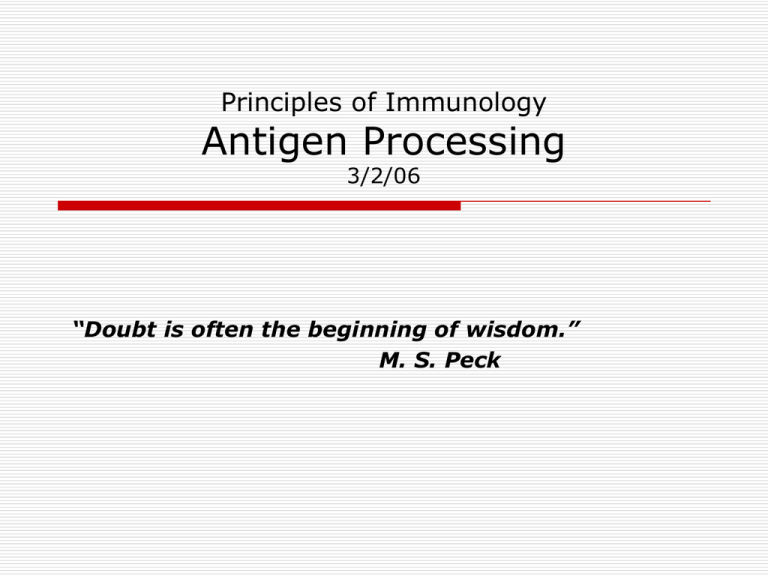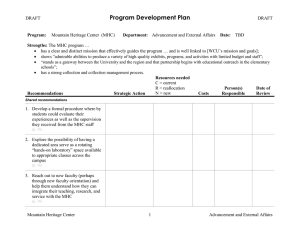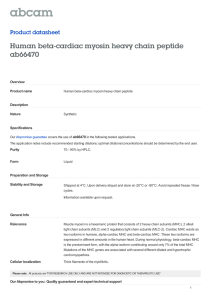Antigen Processing Principles of Immunology 3/2/06 “Doubt is often the beginning of wisdom.”
advertisement

Principles of Immunology Antigen Processing 3/2/06 “Doubt is often the beginning of wisdom.” M. S. Peck Word/Terms List Cytosolic pathway Endocytic pathway Professional APC Proteasome Self-MHC Restriction Self-MHC Restriction T lymphocytes only respond to antigen that is bound to MHC molecules Furthermore the MHC haplotype of the APC must be the same haplotype as that of the lymphocyte This is the principle of Self-MHC restriction Experiment of Zinkernagel and Doherty Self-MHC restriction first demonstrated with T helper (CD4) cells Later shown that CD8 cells also are Self-MHC restricted Used lymphocytic choriomeningitis virus in mice Experiment of Zinkernagel and Doherty Mouse was primed with LCM via blood stream so Ag/lymphocyte interface occurred in spleen Activated T cells were harvested T cells would only respond to MHC presenting target cells of the same haplotype that also had endogenously processed LCM antigens on the surface Requirement for Ag Processing APCs that are “fixed”, i.e. rendering the membrane impermeable are unable to process antigen for T helper cells If fixation is delayed then Ag will have reached the surface of the APC and T helper will be activated OR if the antigen is degraded and then exposed to APC, the APC can still effectively activate T helper Professional APCs All nucleated cells can present Ag to CD8 cells As such these cells become “target cells” because the CTLs will target them for destruction Dendritic cells, macrophages and B lymphocytes are “Professional” antigens presenting cells Professional APCs have MHC II and a costimulatory signal Two Pathways for Antigen Processing Cytosolic and the endocytic pathways Cytosolic-Endogenous antigens Endocytic-Exogenous antigens Cytosolic Pathway This pathway normally controls levels of proteins in cells Sequence Proteins targeted for proteolysis are complexed with ubiquitin Ubiquitin-protein complexes are degraded within proteasomes Peptides are picked up by TAP (Transporter antigen-associated processing) proteins Cytosolic Pathway Sequence(cont’d) ATP hydrolysis (energy requiring) step TAP translocates peptides of 8-10 amino acids into rough endoplasmic reticulum MHC molecule is assembled with peptide Involves three chaperone molecules, calnexin,calreticulin and tapasin Non bound peptides are degraded Endocytic Pathway Mode of Ag entry determines which MHC complex it will bind with and which T lymphocyte will be activated Sequence MHC II molecules are blocked by association with invariant chain MHC II complex travels through Golgi apparatus Invariant chain is degraded leaving CLIP sitting in peptide groove of MHC II molecule HLA-DM catalyses exchange of exogenous Ag peptide Exogenous Ag has gone through ever more acidic endosomes that have degraded it to peptides of 1318 amino acids



![Anti-HLA-DQA1 antibody [HI118] (PerCP) ab91329 Product datasheet Overview Product name](http://s2.studylib.net/store/data/012448198_1-1438860d79d2655f551f9001711a64ba-300x300.png)


